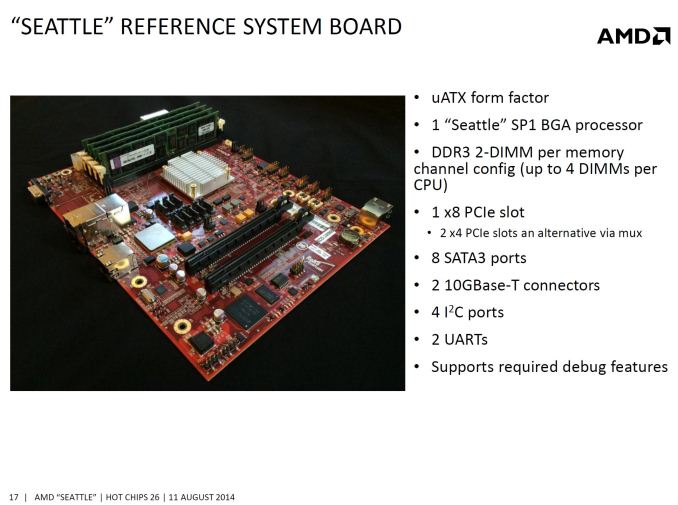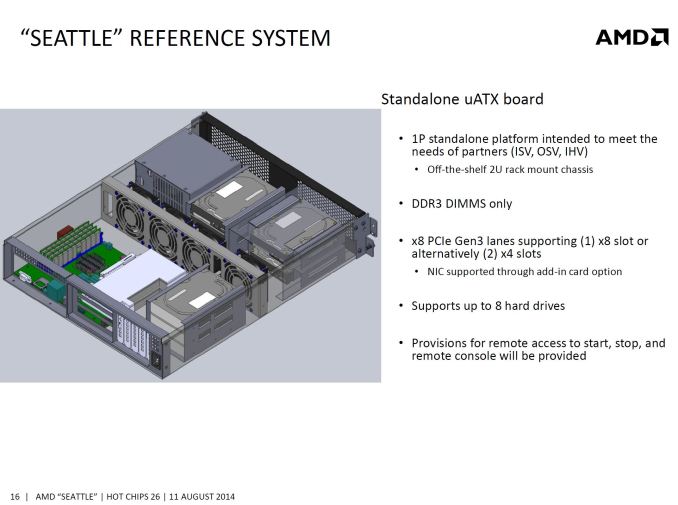AMD’s Big Bet on ARM Powered Servers: Opteron A1100 Revealed
by Stephen Barrett on August 11, 2014 12:00 PM EST- Posted in
- SoCs
- IT Computing
- AMD
- Arm
- Opteron
- server
- Enterprise CPUs
- Opteron A1100
Reference Design and Final Words
With the A1100, AMD is providing system integrators with a reference design µATX motherboard and 2U server rack. These will demonstrate SoC power delivery, IO and boot configuration, as well as SCP connectivity to integrators to utilize in their own designs.
Interestingly, despite the considerable horsepower contained inside the Opteron A1100 compared to previous non-AMD Cortex A9 server designs, AMD's reference server is clearly not specifically targeting web server applications. The reference design is not computationally dense as it only has one 8-core CPU node in a 2U chassis. The design is targeting storage servers with slots for 8 hard drives.
AMD’s presentation mentions a focus on datacenters where IO connectivity and low power consumption are more important than CPU horsepower. AMD certainly has plenty of server experience and will be well positioned to attack this market with this differentiated product. However, I could not shake the feeling AMD was missing an opportunity in micro severs by not targeting the web server application market with a more processor dense reference design. In fact, digging through our own content on the A1100, I found a quote from Anand saying “AMD sees huge demand in the memcached space, cold storage servers and Apache web front ends. The offer is pretty simple: take cost savings on the CPU front and pour it into more DRAM.” I agree with AMD, the A1100 is well suited for datacenter applications- but we only see one incarnation of that with the storage server reference design.
With the acquisition of SeaMicro adding fabric to AMDs long list of expertise, it is surprising to not see a micro server design that connects dozens of these processors together. Calxeda’s Boston Virdis server is exactly that, and our own conclusions stated that the design has huge promise if it was only a bit faster.
Perhaps it is due to excitement about this CPU that I am looking for a more innovative reference server design. All in all, that is not a bad position to be in. Perhaps it is enough to even convince micro sever companies to buy their CPU from AMD instead of designing their own. One thing is for sure, it will be interesting to watch the server market evolve over the next few years. It might not happen, but there could be a day when using your phone to post to Facebook is serviced end-to-end by ARM CPUs.













28 Comments
View All Comments
coburn_c - Tuesday, August 12, 2014 - link
Why are there no 28nm FX products. Why are there no micro atx/mini itx AM3+ boards. Why is AMD walking away from the performance market. Why would anyone buy ARM from AMD when their track record is to walk away from their customers?silverblue - Tuesday, August 12, 2014 - link
There's a lot of "why"s in your post. I doubt they have the money to create a new FX line right now (28nm SHP doesn't clock as highly as 32nm SOI anyway). Their performance CPU lines are not popular enough (and probably too power hungry) to warrant uATX/mITX.As for the last question, AMD have the market experience and are ahead of everybody else in bringing such a product to market. I doubt they'll have their own cake and eat it, but how they get on here will be a good indication for other ARM licensees as to what they can expect from releasing their own products. Besides, if you can't directly compete in traditional markets, you need to possess the agility to look for a market that you can compete in. That is kind of the point - in my eyes - to AMD hiring Rory Read in the first place, and should be answered over the next year.
atlantico - Tuesday, August 12, 2014 - link
AMD probably wants to make sure that the next FX they offer will be an unquestionably worthwhile upgrade. The FX line has been very good, in fact the FX8350 is still the best value chip available for purchase (though the FX8300 is a pretty good value too) - but the competition can offer better performance.Like when the Radeon HD7900 line was introduced, an extremely good value GPU, it still didn't perform as well as the competition and many were reluctant to give credit to that line - but the 7900 GCN chip was a beginning, like the FX8300 line is.
The next major iteration of the architecture must be a worthwhile step up, and I'm sure AMD can deliver on the CPU front as they did on the GPU front, but as the GCN refresh took time, the FX refresh will too.
It will ship when it is ready. AMD is here to stay.
beginner99 - Tuesday, August 12, 2014 - link
Still don't see the point of this. it's niche. Visualization on a full server cores is just as efficient and offers other advantages. Yes it might be cheaper but if the difference of CPU cost usually is negligible in servers running software that costs millions per year.easp - Tuesday, August 12, 2014 - link
If you don't see the point, then you are so far from the target market, you should just skip articles like this in the future.The primary market for this is for orgs that buy servers by the aisle (or data center), particularly those that own most of the software stack that runs on them.
Such people care a lot about power consumption. Balanced system architectures with a good balance between compute, memory bandwidth and I/O tend to be more efficient and can have capital cost advantages as well.
Ammohunt - Thursday, August 14, 2014 - link
Not for OS agnostic highly threaded workloads. I have a lot of backend tasks here where i work that could be offloaded to say a KVM based virtual environment running on ARM. Environmentals are expensive and large blade chassis put a lot of load them.eyours12 - Sunday, August 17, 2014 - link
Cool!cait@asomi.com - Thursday, August 28, 2014 - link
Is the cryptographic co-processor an OpenCL device, or is limited to specific cryptographic functionality. The latter would be a mistake. It takes an ARM design and makes it more like Intel CPUs rather than the approach AMD has been promoting.